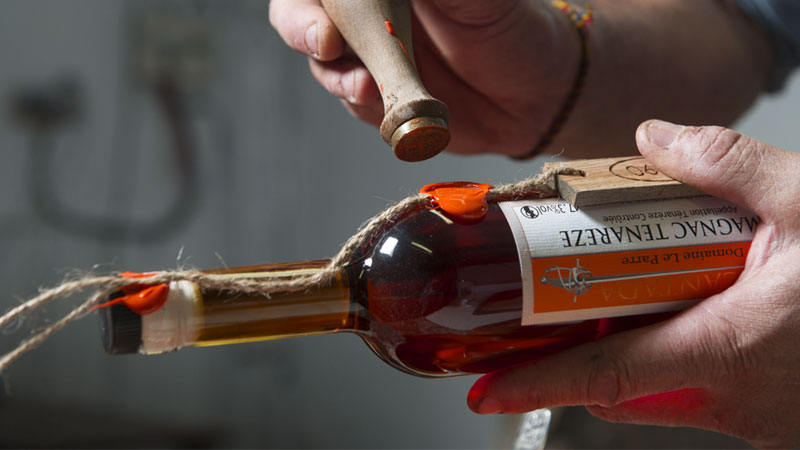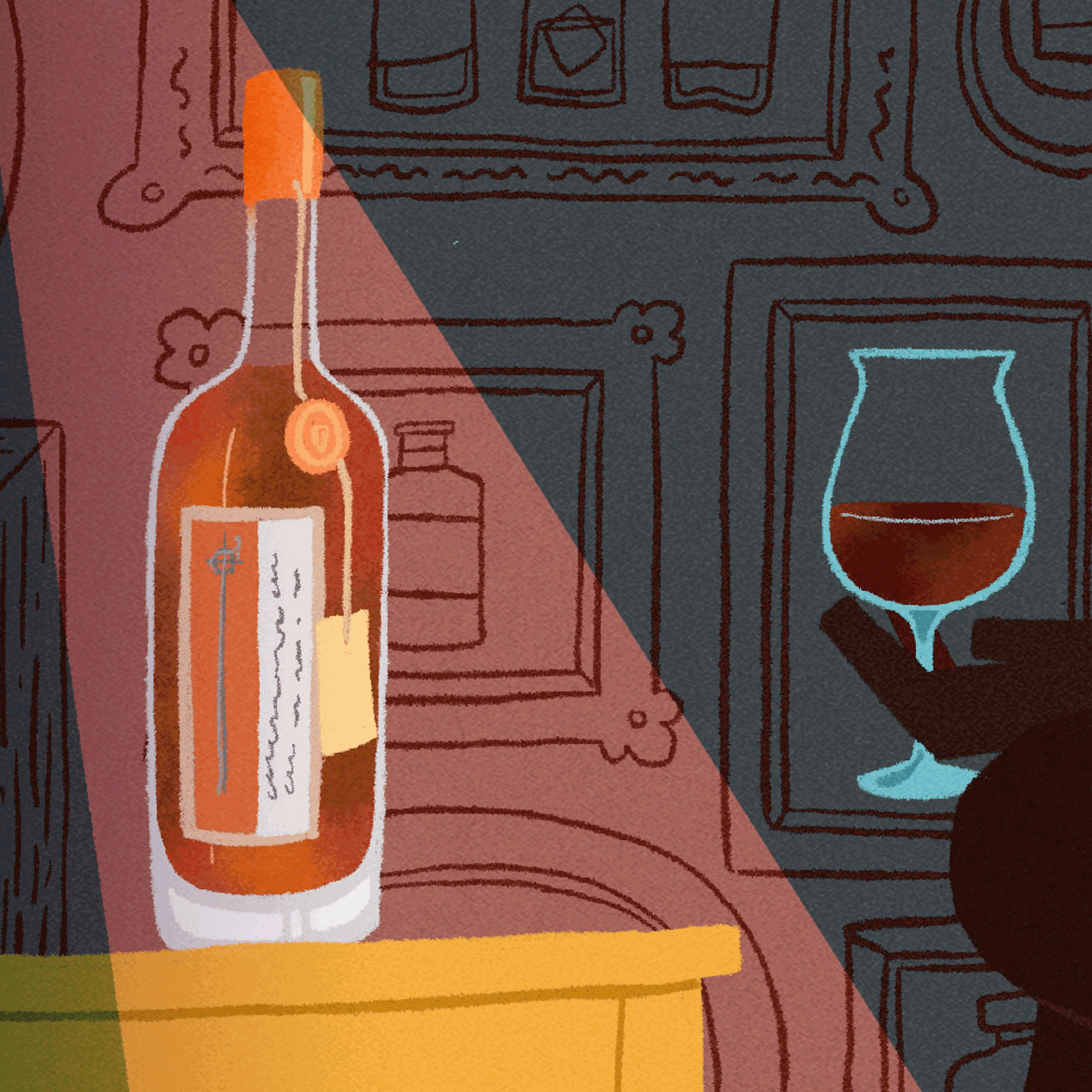It was early 2018 when the orange-waxed necks, with wooden placards on twine hanging from them, first started appearing on social media. If you spend any time trolling bourbon geek accounts on Instagram, or private groups on Facebook, you’ll recognize the repetitive set of images continually populating your feed: Pappy and the Buffalo Trace Antique Collection, of course; Weller, Willett, and Blanton’s, too, and maybe even dusty vintages of Wild Turkey.
Over the last couple years, however, distinct orange-waxed bottles of L’Encantada Armagnac — yes, Armagnac — have begun edging their way into these #bourbonporn posts. How did they get here?
“This stuff tastes more bourbony than other brandies,” explains Steve Ury, who runs the Serious Brandy group on Facebook. “But, of course, once it became popular it sort of developed its own hype.”
Neither Armagnac nor the more prevalent Cognac have ever really been able to capture the modern bourbon drinker’s imagination. Many enthusiasts find them a bit bland, or overly “grape-y.” That’s because both are, of course, grape-based brandies from their eponymous regions in France.
Armagnac has been produced in Gascony, in southwest France, since at least the 13th century. Notably, compared to Cognac, it’s an “earthier”-tasting spirit, as its producers are often much smaller, less technology-advanced grape growers and winemakers who distill their excess fruit via a traveling alembic still that bounces from farm to farm.
That’s especially true in the case of L’Encantada — “The Enchanted One” — which isn’t an Armagnac producer per se, but instead a label that bottles Armagnac from around a half-dozen very tiny estates. At first, it hardly even planned to be a legit business — in 2012, Vincent Cornu, a local caterer and Armagnac nut, was approached by a widow who wondered if he wanted to buy her late husband’s casks.
He did, and Cornu, his wife Christelle, and friend Frédéric Chappe thus formed the “L’Encantada Social Club,” as they jokingly dubbed themselves. They soon started knocking on farmhouse doors throughout the region looking for more Armagnac casks to buy. Many of these “estates,” like The Bidets, a family-owned property that grows grapes and grain while also breeding animals, are run by humble farmers who might distill only a few barrels of Armagnac per year, aging it in their barns, basements, or garages. For many of them, the casks act as a bit of a “retirement fund,” but they were certainly never meant to become an international sensation.
“But as bourbon became more and more difficult to buy — most of us are ‘old hat’ bourbon guys with huge collections from back when it was readily available — we started exploring other spirits,” says Paul Schurman, a Canadian spirits collector living in Switzerland.
When he says “us,” he’s referring to the private, online whiskey group known as 1789b of which he is a longtime member. In 2015, Ury, a fellow member, turned Schurman onto more whiskey-like Armagnac and he began seeking them out. Schurman ordered a couple of bottles of L’Encantada Domaine Lous Pibous 1994 online from Paris’s acclaimed Maison du Whisky, and immediately realized he’d found a big winner.
When he sent one to Ury, he was likewise blown away. A lawyer by day, then living in the Los Angeles area, Ury might have been the first American to really fall for L’Encantada, writing about it on his blog in the summer of 2016. He particularly loved its unique flavor profile, which he knew was atypical for Armagnac.

“Most Armagnac is aged in used oak and then re-racked and such during aging,” Ury explains. “The Pibous is aged in new oak and then they just let it sit. The result is an oaky, high-proof Armagnac that tastes a lot like… bourbon, really good bourbon.”
Both he and Schurman couldn’t help but compare it to the 17- and 18-year-old Bernheim “wheaters” that Willett had released in the mid-2000s, “the kind you don’t get any more,” Ury wrote on his blog at the time. If those Willett bourbons were now selling on the secondary market for thousands of dollars, here was an unexpected replacement, for a mere €90 a bottle.
“After tasting this, I had one thought,” Ury wrote of the Lous Pibous 1994. “We have to get more.”
Unfortunately, L’Encantada wasn’t distributed to the U.S. So, Schurman and Ury decided to try to import a few L’Encantada casks themselves, partnering with two other whiskey enthusiasts, Daniel Walbrun and Steve Neese, and dubbing themselves “The Brandy Brothers.” It wouldn’t be easy at first; Cornu spoke spotty English, and had never actually sold an entire cask. In fact, he’d never been able to penetrate the American market whatsoever. His problem was, he was trying to sell atypical Armagnac to typical brandy drinkers — not bourbon geeks.
“It was so off-profile to what Armagnac people liked,” explains Schurman. “But anyone who liked a George T. Stagg or a Weller [bourbon] would love it. Sometimes, they wouldn’t even know it was an Armagnac.”
Still, Schurman knew that even if he was keen on this spirit, it was still quite a financial risk to buy three entire Lous Pibous barrels — a 1993 vintage (Cask 124) and two 1996s (Casks 187 and Cask 188) — or around 1,000 bottles-worth.
He shouldn’t have been concerned. Fellow 1789b group members would snap up almost all of the bottles before they ever hit store shelves at K&L Wines, the local California retailer they had to use to get L’Encantada imported into the States. Word of L’Encantada quickly spread within the insular bourbon community.
“We knew these were special, but they were still Armagnac, a spirit which I love but which has limited appeal in the U.S.,” wrote Ury.
Ury never expected “the enchanted one” to blow up the way it has, but maybe he should have. L’Encantada bottlings check all the boxes for the American bourbon geek: single casks, barrel-strength, unfiltered and unadulterated; and lavishly packaged with wax-dipped necks, wooden hang tags (listing vintage year), and the requisite, dignified boxes. They are also exceedingly rare, with around 300 bottles per release; and, as for now, they are relatively cheap, especially compared to still-booming bourbon. (Ury doesn’t quite agree with my assessment, saying, “Maybe, but other brandies have those things.”)
L’Encantada bottlings quickly became a cult phenomenon among the bourbon community. A feeding frenzy followed. As demand begat supply, more releases entered the market. The Brandy Brothers brought in three more casks, K&L purchased two more for the store, and other retailers across the country began grabbing any barrels they could. Notably, Astor Wines & Spirits in Manhattan, and the esteemed Lincoln Road Package store in Hattiesburg, Miss., long famous for astute single barrel offerings, were among those to snatch up barrels.
“We weren’t selling much Armagnac at all — one or two in the store. But those were usually 80 proof and mellow,” says Jamie Farris, the owner of the Lincoln Road, whose first two L’Encantada casks were a Domaine Le Frêche and a Lous Pibous. He’s since acquired three more. “[The L’Encantada] are bigger, bolder brandies than you’re used to.”
As early as the summer of 2018, the Manhattan Wine Company’s newsletter, in lauding L’Encantada, purported that Your New Favorite Brown Spirit is Not from Kentucky. Around the same time, the acclaimed PM Spirits teamed up with L’Encantada to release XO, a blend of four L’Encantada casks (two Lous Pibous, as well as Del Cassou and Bellair estate), and up to that point, their most widely accessible release. In announcing the release, PM Spirits founder Nicolas Palazzi explained:
“L’Encantada is the darling of bourbon whiskey clubs, offering power, richness, and excitement for whiskey drinkers looking to explore.” While Astor Wines, in introducing the XO, cheekily noted: “Bourbon what? Pappy who?”
Nevertheless, while the online cognoscenti will surely be pissed I’ve blown up their latest love, for the most part L’Encantada still hasn’t fully made it into the mainstream of moneyed bourbon neophytes calling around to stores looking for “the Pappies.” PM released a Lot 2.0 of XO last summer, and I still see bottles of it on shelves. Likewise, single cask bottlings of L’Encantada can still be found in certain stores as well, though the prices have steadily been creeping up, with most selling for around $200 to $250 these days, double or triple what they were just a few years ago.
But, of course, those prices still aren’t at bourbon levels where new bottles of Pappy Van Winkle 23 Year Old hit the market at an asking price of around $2,000. Nonetheless, if most bourbon drinkers had never even tasted an Armagnac a year ago, now a good number are obsessed with at least one brand of it. A year or two from now, we all might be kicking ourselves for not capitalizing on it.
“The bourbon guys wanted something different,” Farris says. “And it filled that void. Something different, but a better value. You can’t find a 23-year-old bourbon for 200 bucks these days.”
